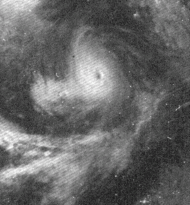ATS-1
|
The ATS-1. | |
| Mission type | Weather Satellite |
|---|---|
| Operator | NASA |
| COSPAR ID | 1966-110A[1] |
| SATCAT № | 02608 |
| Mission duration | 17 years |
| Spacecraft properties | |
| Bus | HS-306 |
| Manufacturer | Hughes Aircraft |
| Launch mass | 352 kilograms (776 lb) |
| Start of mission | |
| Launch date | December 7, 1966, 02:12:01 UTC |
| Rocket | Atlas SLV-3 Agena-D |
| Launch site | Cape Canaveral LC-12 |
| Orbital parameters | |
| Reference system | Geocentric |
| Regime | GEO |
| Semi-major axis | 42,152.0 kilometres (26,192.0 mi) |
| Eccentricity | 0.00013 |
| Perigee | 35,782.0 kilometres (22,233.9 mi) |
| Apogee | 35,793.0 kilometres (22,240.7 mi) |
| Inclination | 3.6º |
| Period | 1,435.5 minutes |

ATS-1 (Applications Technology Satellite) was the first experimental equatorial synchronous satellite.[2] Though intended as a communications satellite rather than as a weather satellite, it carried the Spin Scan Cloud Camera developed by Verner E. Suomi and Robert Parent at the University of Wisconsin. After entering a geostationary orbit at 23,000 mi (37,000 km) above Earth, initially in orbit over Ecuador, it transmitted weather images from the Western Hemisphere, as well as other data, to ground stations, including well as video feeds for television broadcasting. "For the first time," historians would note later, "rapid-imaging of nearly an entire hemisphere was possible. We could watch, fascinated, as storm systems developed and moved and were captured in a time series of images. Today such images are an indispensable part of weather analysis and forecasting." [3]
It was the first satellite to use frequency-division multiple access which accepted multiple independent signals and downlinked them in a single carrier. The spacecraft measured 56 inches (1,400 mm) in diameter, 57 inches (1,400 mm) high and weighed 750 lb (340 kg).[4]
The ATS-1 satellite was used during the 1967 international television broadcast Our World, providing a link between the United States and Australia during the program.
The ATS-1 would remain operational for more than 18 years, until April, 1985.[5]
Features
This satellite was cylindrical, with a diameter of 142 cm (56 in) and a height of 135 cm (53 in); an additional 270 cm (110 in) in height was the engine cover. The surface was covered with solar panels, and the whole satellite was stabilized by rotation.
Instruments
A total of fifteen experiments were conducted during the mission:[6]
- Suprathermal Ion Detector
- Biaxial Fluxgate Magnetometer
- Omnidirectional Spectrometer
- Electron Spectrometer
- Particle Telescope
- Solar Cell Radiation Damage
- Thermal Coating Degradation
- Rate Range Beacon
- Spin-Scan Camera cloudcover
- Microwave communication transponder
- Communication VHF transponder
- Nutation sensor
- Resist-Jet Thruster
- Faraday Rotation
- Meteorological Data Relay System
References
- ↑ NASA - NSSDC - Spacecraft - Details
- ↑ Su-Yin Tan, Meteorological Satellite Systems (Springer Science & Business Media, 2013) p44
- ↑ Stanley Q. Kidder and Thomas H. Vonder Haar, Satellite Meteorology: An Introduction (Gulf Professional Publishing, 1995) p7
- ↑ Missions - ATS - NASA Science
- ↑ Michel Capderou, Handbook of Satellite Orbits: From Kepler to GPS (Springer Science & Business, 2014) p279
- ↑ Experiment Search Results. NASA NSSDC Master Catalog. Retrieved 2016-22-05.
.jpg)